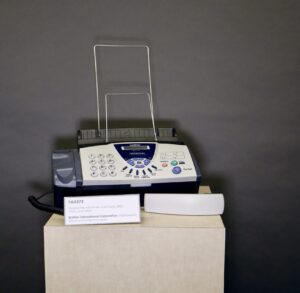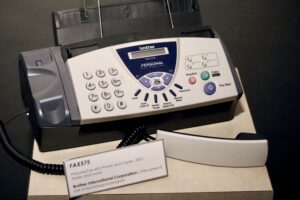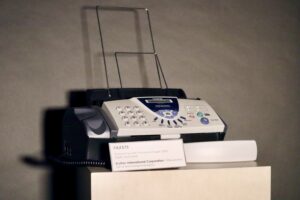
FAX575 Personal Fax with Phone and Copier, 2003 Plastic and Metal Brother International Corporation Gift of technological progress
Fax machines, now almost obsolete in today’s office culture, have a fairly uninspiring history with two notable exceptions: Napoleon used an early version of the machine and this April Fool’s prank.
While fax machines were used frequently in the 1980s and 1990s, the technology that made them successful can be traced to the mid-nineteenth century. Invented by Alexander Bain in 1843, the “Electric Printing Telegraph” utilized a pendulum-mounted stylus to scan a two-dimensional surface. His early version of the fax machine worked, but the Electric Printing Telegraph produced images of poor quality. English physicist Frederick Bakewell improved upon Bain’s invention by using cylinders to transmit and recieve images and demonstrated the first public facsimile transmission in 1851.
Italian inventor Giovanni Caselli introduced the first commercial facsimile system between Lyon and Paris, France in 1863. Known as the “pantelegrafo,” or pantelegraph, Caselli’s invention is considered the first reliable fax machine. In 1860, Caselli demonstrated the pantelegraph for

FAX575 likely received its last fax before 2010
French Emperor Napoleon III, who was impressed with its ability to transmit a signature over a long telegraph line. After successful tests, the pantelegraph was accepted for use by law across France.
In the 1980s, telephone companies embraced the facsimile standard which led to a surge in fax technology as a method of communication. At the height of its popularity, the fax machine was one of the most universally used forms of communication.
With the rapid development of technology, the ability to email, message, airdrop, and share content with extreme ease, the fax machine no longer holds the power it once did in the workplace. The rise of computers, smartphones, and mobile devices has made it possible to access information and communicate with others from virtually anywhere in the world. As a result, the once ubiquitous fax machine has become a historical relic, relegated to museums and nostalgia-driven conversations about the way things used to be.

FAX575 Personal Fax with Phone and Copier, 2003 Plastic and Metal Brother International Corporation Gift of technological progress
